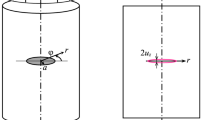Abstract
A mathematical model of a circular disk-shaped brittle crack whose faces are acted upon by cohesive forces, whose magnitude depends on the distance between the faces. An algorithm of numerical solution of the singular nonlinear improper integral equation defining the crack profile was developed which can be used for other integral equations of this type. It is shown that taking into account the coupling forces between the crack faces leads to their gradual closing with distance from the center of the crack.
Similar content being viewed by others
References
E. M. Kartashov, B. Tsoi, and V. V. Shevelev, Structural and Statistical Kinetics of Fracture of Polymers (Khimiya, Moscow, 2002) [in Russian].
V. R. Regel’, A. I. Slutsker, and E. E. Tomashevskii, Kinetic Nature of the Strength of Solids (Nauka, Moscow, 1974) [in Russian].
V. V. Shevelev and E. M. Kartashov, “Some Statistical Aspects of Brittle Fracture and Durability of Polymers. Materials with Cracks,” Vysokomolekulyar. Soed. 39B(2), 371–381 (1997).
M. Ya. Leonov and V. V. Panasyuk, “Development of Tiny Cracks in Solids,” Prikl. Mekh. 5(4), 391–401 (1959).
D. S. Dugdale, “Yielding of Steel Sheets Containing Slits,” J. Mech. Phys. Solids 8, 100–104 (1960).
Yu. P. Raizer, “Physical Foundations of the Theory of Brittle Fracture Cracks,” Usp. Fiz. Nauk 100(2), 329–347 (1970).
L. D. Landau and E. M. Lifshits, Course of Theoretical Physics, Vol. 7: Theory of Elasticity (Nauka, Moscow, 1987; Pergamon Press, 1975).
V. V. Shevelev and R. A. Osipov, “Model of the Crack Profile with the Cohesive Forces between the Crack Faces,” in Abstracts Int. Conf. Mathematics. Computer. Education, Pushchino, January 24–29, 2011 (Regularnaya i Khaoticheskaya Dinamika, Izhevsk, 2011).
I. S. Berezin and N. P. Zhidkov, Computational Methods (Fizmatgiz, Moscow, 1960) [in Russian].
Advanced Numerical Integration in Mathematica (Wolfram Res. Inc., Champaign, 2008).
Wolfram Mathematica Tutorial Collection (Wolfram Res. Inc., Champaign, 2008).
M. Trott, The Mathematica Guidebook for Numerics (Wolfram Res. Inc., Springer, 2006).
V. V. Shevelev, “Criterion of Brittle Fracture and Durability of Materials under Thermomechanical Action,” Inzh.-Fiz. Zh. 81(2), 394–400 (2008).
Author information
Authors and Affiliations
Corresponding author
Additional information
Original Russian Text © V.V. Shevelev, R.A. Osipov.
__________
Translated from Prikladnaya Mekhanika i Tekhnicheskaya Fizika, Vol. 54, No. 3, pp. 170–180, May–June, 2013.
Rights and permissions
About this article
Cite this article
Shevelev, V.V., Osipov, R.A. Mathematical model of a brittle crack that takes into account the distribution of cohesive forces between the crack faces and the distance between them. J Appl Mech Tech Phy 54, 491–499 (2013). https://doi.org/10.1134/S0021894413030206
Received:
Revised:
Published:
Issue Date:
DOI: https://doi.org/10.1134/S0021894413030206




